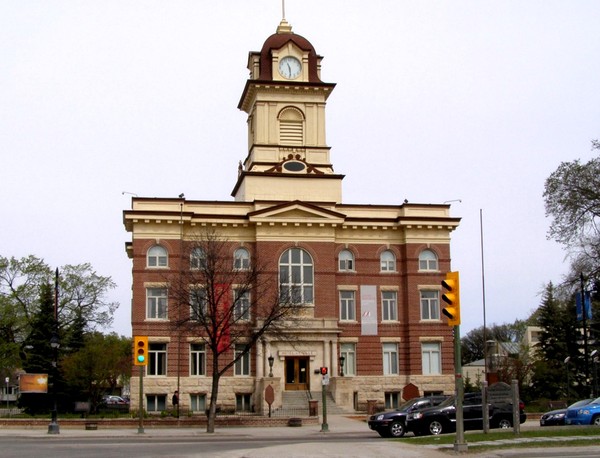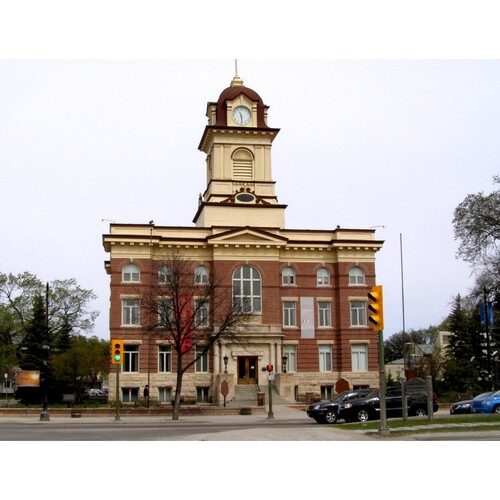
Source: Courtesy of Wikimedia Commons
HORWOOD, VICTOR WILLIAM, architect, author, office holder, militia officer, and gentleman farmer; b. 27 Feb. 1874 in Frome, England, son of Harry Horwood and Ellen Mary Long; m. 18 Sept. 1906 Claratina Taylor in Winnipeg; d. 15 March 1939 in Matlock, Man.
Victor William Horwood’s father was a stained-glass artist who immigrated to Canada and set up his business in Prescott, Ont., in 1876. Victor, his mother, and his brothers arrived later, probably in 1881. Victor was educated in the public schools of Prescott and he studied art in New York and Minneapolis, Minn. On his return to Canada, he entered the Ottawa office of his elder brother, architect Edgar Lewis Horwood, and learned the profession. He later worked in Montreal, Toronto, and Chicago for brief periods. As he would explain in an article published in 1932, his “adventuring in search of architectural knowledge throughout the continent” brought him to Winnipeg in February 1904.
In that year Horwood designed a school at Fort William (Thunder Bay), Ont., and a residence for Mrs G. Nagy in Winnipeg. During 1905 his practice became more firmly established with commissions such as residences for businessmen John Sutton, William Chandler Birt, and William G. Bell, and an apartment building known as the Bell Block. His design for a school in Virden would be followed by others for schools in Sintaluta, Sask. (1906), Innisfail, Alta (1907), and Kildonan (Winnipeg) (1908). He became associated with the Riverview Realty Company, which was developing a luxury subdivision in the Fort Rouge area of Winnipeg, and in 1906 he had a house constructed in Riverview in anticipation of his marriage to Claratina, daughter of Thomas William Taylor, mla and former mayor of Winnipeg.
In February 1905 Horwood had begun publishing house designs in the Western Home Monthly. The series, which also included plans for a poultry house, church, and barn, continued until December 1910. During that period Horwood was responsible for a number of substantial Winnipeg apartment blocks for John and William Moxam, including Moxam Court (1907), Waldron Court (1909), MacMillan Court (1910), and the Vansittart apartments (1910), and for the Keewatin Beach Hotel (1909), which may not have been built. He is also known to have been the architect for at least two churches in the city, St Paul’s Presbyterian (1906–7) and the smaller Holy Cross Evangelical Lutheran (1910). Among the municipal buildings he designed were the St Boniface City Hall (1905–6) and nearby Fire Hall No.1 (1907–8). In addition, he provided plans for a tar-paper factory at Elmwood (Winnipeg) for Merrick, Anderson and Company (1908), the Avenue Theatre (1910–11) in Winnipeg, and a number of residences, some designed to client specifications and others intended for resale. Many of his buildings had neoclassical motifs, which were then quite fashionable.
Horwood’s private practice was probably never very large because he had set himself up in competition to many long-established architects such as John Hamilton Gordon Russell*, Joseph Greenfield, and Samuel Frank Peters, whose operations took in much of the available work. Nationally known firms such as Darling and Pearson [see John Andrew Pearson; Frank Darling*], Edward and W. S. Maxwell [see Edward Maxwell*], and Sproatt and Rolph [see Henry Sproatt], and American companies such as Carrère and Hastings and Warren and Wetmore, had also found clients in Winnipeg, leaving the market finely divided. Horwood’s business may have been further limited by his retiring character. Surviving impressions indicate that he was probably not an outgoing person, though he was a charter member of the local lodge of the Knights of Pythias (1906), belonged to the T-Square Society and the Manitoba Society of Artists, and lectured on architecture to the Young Men’s Christian Association.
On 17 Jan. 1911 Horwood was appointed assistant to the provincial architect, Samuel Hooper*. His Conservative leanings and the influence of his father-in-law may have helped him obtain the position. He closed his private practice. The appointment gave him a steady income and allowed Horwood and his wife to move to the more upper-class Wellington Crescent, where they built a new house during 1911–12. After Hooper’s sudden death Horwood was confirmed as provincial architect on 2 Nov. 1911, and, according to a contemporary source, he became responsible for “all the architectural work and building construction undertaken by the province, involving the expenditure of millions of dollars yearly.” At that time, the Conservative government of Rodmond Palen Roblin was in the second phase of an ambitious building program initiated by Hooper during 1905–6. This phase entailed the completion of a new agricultural college at St Vital (Winnipeg) and the erection of new structures in other cities and towns. An important part of the program involved the construction in Winnipeg of the new Law Courts Building (1913–16) and the neighbouring Central Power House (1915), both of which were designed by Horwood. The most important commission was not to be his, however. After a competition held throughout the British empire early in 1912, the contract for the design of a new legislative building was awarded to English architect Frank Worthington Simon and his partner, Henry Boddington. The provincial architect’s office would provide staff and perform routine tasks for Simon and would act as a buffer between him and local politicians. Horwood wrote an article on the project, which appeared in the November 1912 issue of Construction.
In July 1913 Horwood was appointed supervising architect on the legislative project in lieu of Simon. Supporters of the government insisted that the nomination was to placate Canadian architects who had objected to the presence of non-Canadians in the competition. Critics of the government would later allege that the assignment had given the Conservative Party complete control of the project.
Work on the legislative buildings began in August 1913. The following year, when the government announced that the structure, initially to cost about $2.8 million, would require an additional $1.75 million, Tobias Crawford Norris’s Liberal opposition, which had suspected negligence and corruption, demanded an investigation. The royal commission appointed to inquire into certain matters relating to the new parliament buildings was established on 1 April 1915 and headed by Chief Justice Thomas Graham Mathers. There were difficulties: the government had destroyed key documents; the contractor, Thomas Kelly, was not cooperative; and Horwood, an important witness, had left for Rochester, Minn., to have a malignant growth removed from his face, and was involved in keeping another witness, William Salt, assistant inspector of the buildings, in the United States. Nonetheless, the commission uncovered evidence of shoddy construction and government cover-ups. Kelly had grossly overcharged for materials and work and had made substantial kickbacks to the Conservative Party. Salt had falsified his records of caisson inspections at the urging of Horwood, who, in turn, had acted on the orders of his superiors. The provincial architect had probably assumed the role of cat’s paw for his political masters. The Roblin government resigned on 12 May; Horwood followed on 27 May. While recovering in Minneapolis, he stated to a Winnipeg Telegram reporter that he felt that he had been made the “goat” in the scandal. He added that he had been ruined financially and professionally; he would never practise again. Granted immunity from prosecution, he testified before commission members in Minneapolis against his former employers, incriminating several people.
Horwood and his wife sold their home on Wellington Crescent in the spring of 1916 and took up homesteading west of Matlock, where he remained, leading the life of a gentleman farmer. An officer in the militia since at least 1907, he had resigned his commission as captain of G Company in the 90th (Winnipeg) Battalion of Rifles in March 1914, citing his exacting duties as provincial architect, but he would remain a member of the Independent Order of Odd Fellows and the freemasons until his death. Occasionally, he contributed a short story, poem, or artwork to the Winnipeg Evening Tribune, the Manitoba Free Press, or the Western Home Monthly. In August 1919 he began to publish another series of plans for residences and other structures in the Farmer’s Advocate and Home Journal. These would run until 1924. The home series resumed in the Nor’-West Farmer in February 1926 and continued until the end of April 1936, restarted in the Country Guide and Nor’-West Farmer of May 1937 and ended in February 1938. The articles appear to have provided him with a modest income. Aside from this output, he had prepared an unpublished 100-page history of the Manitoba Association of Architects. He died in 1939 and was buried in the Taylor family plot at Brookside Cemetery in Winnipeg. A competent architect in a crowded professional field, he had fallen victim to political gamesmanship.
Victor William Horwood is the author of “Designs for stable,” Canadian Architect and Builder (Toronto), 19 (1906): 134–35, “The new legislative and executive building, Winnipeg, Manitoba,” Construction (Toronto), 5 (1912): 69–78, and “Down the years,” Nor’-West Farmer and Farm and Home (Winnipeg), 20 June 1932. He also published architectural plans for residences and other structures in Western Home Monthly (Winnipeg) from February 1905 to December 1910, Farmer’s Advocate and Home Journal (Winnipeg) from August 1919 to April 1924, Nor’-West Farmer (Winnipeg) and the publication that succeeded it, Nor’-West Farmer and Farm and Home (Winnipeg), from February 1926 to April 1936, and the Country Guide and Nor’-West Farmer (Winnipeg) from May 1937 to February 1938.
AM, D 309 (Knights of Pythias), f.2; P 6837 (Winnipeg T-Square Society). City of Winnipeg, Arch. and records control branch, City Clerk’s dept., building permits, 1906–10. GRO, Reg. of births, Frome, 9 April 1874. LAC, R233-37-6, Ottawa, Central Ward, dist.100, subdist.b-4. Man., Dept. of Tourism, Culture, Heritage, Sport and Consumer Protection, Vital statistics agency (Winnipeg), no.1906-001784. Manitoba Free Press, 28 May, 16 July, 15 Aug. 1904; 6 April, 6, 17 May, 8, 29 July 1905; 28 June 1906; 1 April 1907; 23 May, 14 Nov. 1908; 13 March, 29 May 1909; 1 Nov. 1911; 21 April, 28 May 1915; 9 Aug. 1930. Manitoba Gazette (Winnipeg), 28 Jan., 18 Nov. 1911. La Minerve (Montréal), 3 janv. 1881. Winnipeg Telegram, 5 Oct. 1907; 1 Oct. 1910; 9 March 1914; 21 April, 6, 27, 28, 31 May, 10–11 June 1915. Winnipeg Tribune, 25 April 1906, 5 Aug. 1907, 4 May 1909, 20 March 1937, 15 March 1939, 27 Jan. 1940. Marilyn Baker, Symbol in stone: the art and politics of a public building: Manitoba’s third legislative building (Winnipeg, 1986). Man., Royal commission to inquire into certain matters relating to the new parliament buildings, Report (Winnipeg, 1915). Provincial government of Manitoba: various public buildings (Winnipeg, [1911?]). F. H. Schofield, The story of Manitoba (3v., Winnipeg, 1913). Who’s who in Canada, 1922.
Cite This Article
Randy R. Rostecki, “HORWOOD, VICTOR WILLIAM,” in Dictionary of Canadian Biography, vol. 16, University of Toronto/Université Laval, 2003–, accessed April 28, 2025, https://www.biographi.ca/en/bio/horwood_victor_william_16E.html.
The citation above shows the format for footnotes and endnotes according to the Chicago manual of style (16th edition). Information to be used in other citation formats:
| Permalink: | https://www.biographi.ca/en/bio/horwood_victor_william_16E.html |
| Author of Article: | Randy R. Rostecki |
| Title of Article: | HORWOOD, VICTOR WILLIAM |
| Publication Name: | Dictionary of Canadian Biography, vol. 16 |
| Publisher: | University of Toronto/Université Laval |
| Year of revision: | 2015 |
| Access Date: | April 28, 2025 |



